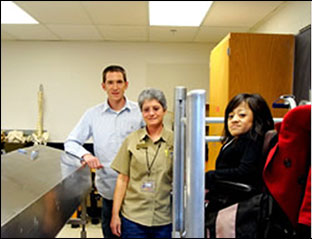
Photo by Melanie O. Massengale |
| Left to right: Adam Hayes, Mary Romano, and Teresa Nguyen demonstrate the lift that accommodates Nguyen's work at the table in the lab. |
Teresa Nguyen, who uses a wheelchair, simply wanted the same classroom experience that other students undergo in her human anatomy lab in Ramaley 268. What transpired was a remarkable collaboration among the departments of Integrative Physiology, Disability Services and Facilities Management that ensured her full participation in class.
"With an interest in a medical career, I am in the lab to work on human cadavers, but the tables are too high for me to reach and cannot be lowered," said Nguyen, a senior majoring in Integrative Physiology. "Two weeks into the semester I needed to get accommodation because cadaver work was about to begin, so I talked to our lab coordinator Adam Hayes to see what we could do."
Nguyen and Hayes contacted Karen Rosenschein, assistant director of Disability Services. Rosenschein had worked with Nguyen previously on several projects, including a retrofit for her room in Libby. Rosenschein then got in touch with structural trades analyst Mary Romano, the accommodations liaison at Facilities Management.
"I always call Mary and she takes care of everything, reaching everyone who needs to be involved to get the work done," Rosenschein said. "She also follows up later to see that all parties are satisfied."
Rosenschein and Romano had already begun working closely together on access issues in 2008 as a result of contact at a community forum on disability access sponsored by Disability Services.
"Several of us from Facilities Management, including my manager, Tom Miller, who is the structural trades manager, attended the forum since we wanted to do more to interact with Disability Services to make accommodations for students who need them," Romano said.
To make the Ramaley accommodation, Hayes, Romano and Miller met with Nguyen at the lab. "We tried to figure out first what Teresa's needs were, and what the lab could handle," Romano said. "Adam Hayes and Ruth Heisler, his colleague in Integrative Physiology, were both instrumental in this. They both wanted to do whatever they could to make sure the lab was fully accessible for Teresa."
The group discussed several possibilities, including building a ramp or platform, but these options were not feasible in the space available. Miller and Romano then remembered a mechanical lift owned by Facilities Management that ordinarily is stored in the Coors Events Center and is used during commencements and other events.
"We had never before used it in a different situation, so this was a first for us," Romano said. "It's good to know that we have it for other students in the future."
When the meeting was over, she and Miller immediately went to the Events Center and had the lift moved to Ramaley to test it in time for the class's cadaver work, due to begin the following Monday. The move was completed the same day.
"Mary met with us at Ramaley at 9 a.m. on Friday, and came back around noon with the lift and a crew of five or six to move it," Hayes said. "The biggest obstacle was getting it onto the elevator and then into the room. It required some disassembly, but by 3:30 p.m. we were done. It was remarkable," he said. Added Romano: "We couldn't have done it without the teamwork of the Structural Trades Shop."
Teresa tried out the lift and pronounced it satisfactory.
"Actually getting to see the cadaver, to get the full classroom experience that other students have, is worthwhile to me," Nguyen said. "The fact that Adam and Karen listened to my suggestions, that Tom and Mary found the lift, and they all made it happen, that's important, too, because without all their cooperation I wouldn't be receiving the same experience in that lab."
For assistance with student or departmental disability access, contact Disability Services at 303-492-8671.

|